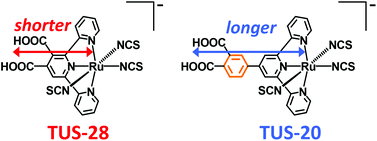Ruthenium sensitizers having an ortho-dicarboxyl group as an anchoring unit for dye-sensitized solar cells: synthesis, photo- and electrochemical properties, and adsorption behavior to the TiO2 surface†
Abstract
A novel ruthenium sensitizer ((TBA)[Ru(3′,4′-dicarboxyterpyridine)(NCS)3], TBA = tetrabutylammonium, TUS-28) has been synthesized as an improved model sensitizer for (TBA)[Ru(4′-(3,4-dicarboxyphenyl)terpyridine)(NCS)3] (TUS-20). The molar absorptivity of TUS-28 in the whole visible region was smaller than that of TUS-20 due to the absence of the phenyl ring at the terpyridine ligand. On the other hand, the energy levels of HOMO and LUMO of TUS-28 were still suitable for effective electron transfer reactions in dye-sensitized solar cells (DSCs). TUS-28 did not show a superior adsorptivity to the TiO2 surface just like TUS-20, even though TUS-28 has an ortho-dicarboxyl group which is reported to be an efficient anchoring unit. ATR-IR measurements revealed that both carboxyl groups of TUS-28 participate in binding to the TiO2 surface just like TUS-20. Therefore, steric hindrance between the hydrogen atom at the 4-position of 3′,4′-dicarboxyterpyridine and the OH group at the TiO2 surface seems to retard the rapid adsorption, and to weaken the binding strength of TUS-28. The DSC with TUS-28 showed 8.2% conversion efficiency, which is higher than that of TUS-20 (7.5%). The Jsc value of the DSC with TUS-28 was larger than that of TUS-20 even though the amount of dye adsorption of TUS-28 was smaller than that of TUS-20. A more effective electron injection reaction is considered to contribute mainly to the efficiency improvement of TUS-28 since the path length of the electron injection from TUS-28 to the conduction band of the TiO2 is shorter than that of TUS-20 due to the absence of the phenyl ring.


 Please wait while we load your content...
Please wait while we load your content...